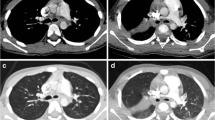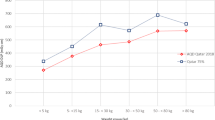Abstract
The objective of this study was to analyze image quality of chest examinations in pediatric patients using computed radiography (CR) obtained with a wide range of doses to suggest the appropriate parameters for optimal image quality. A sample of 240 chest images in four age ranges was randomly selected from the examinations performed during 2004. Images were obtained using a CR system and were evaluated independently by three radiologists. Each image was scored using criteria proposed by the European Guidelines on Quality Criteria in Pediatrics. Mean global scoring and scoring of individual criteria more sensitive to noise were used to evaluate image quality. Agfa dose level (DL) was in the range 1.20 to 2.85. It was found that there was not significant correlation (R < 0.5) between image quality and DL for any of the age ranges for either global score or for individual criteria more related to noise. The mean value of DL was in the ranges 1.9–2.1 for the four age bands. From this study, a DL value of 1.6 is proposed for pediatric CR chest imaging. This could yield a reduction of approximately a factor of 2.5 in mean patient entrance surface doses.








Similar content being viewed by others
Abbreviations
- DL:
-
Dose level
- CR:
-
Computed radiography
- ICRP:
-
International Commission on Radiological Protection
- PSP:
-
Photostimulable phosphor plate
- ESD:
-
Entrance surface dose
- HMD:
-
Hyaline membrane disease
References
European Commission: Council directive 97/43/Euratom health protection of individuals against the dangers of ionizing radiation in relation to medical exposure. Off J Eur Communities L180:22–27, 1997
Don S: Radiosensitivity of children: potential for overexposure in CR and DR and magnitude of doses in ordinary radiographic examinations. Pediatr Radiol 34(Suppl 3):S167–S172, 2004 Oct
Peters SE, Brennan PC: Digital radiography: are the manufacturers’ settings too high? Optimisation of the Kodak digital radiography system with aid of the computed radiography dose index. Eur Radiol 12(9):2381–2387, 2002
Commission of the European Communities: European guidelines on quality criteria for diagnostic radiographic images in pediatrics. (Office for Official Publications of the European Communities, Luxembourg), Report EUR 16261. CEC 1996.
Schaetzing R: Management of pediatric radiation dose using Agfa computed radiography. Pediatr Radiol 34(Suppl 3):S207–S214, 2004 Oct
International Commission on Radiological Protection: Managing patient dose in digital radiology. ICRP. Publication 93 Annals of the ICRP (2004).
Huda W, Rill LN, Bruner AP: Relative speeds of Kodak computed radiography phosphors and screen-film systems. Med Phys 24(10):1621–1628, 1997
Agfa-Gevaert: ADC Compact Dose Monitoring Software User Manual. Mortsel, Belgium: Agfa-Gevaert, 1998
Vano E, Fernandez JM, Ten JI, Guibelalde E, Gonzalez L, Pedrosa CS: Real-time measurement and audit of radiation dose to patients undergoing computed radiography. Radiology 225(1):283–288, 2002 Oct
Mohamadain KEM et al: Dose evaluation for paediatric chest x-ray examinations in Brazil and Sudan: low doses and reliable examinations can be achieved in developing countries. Phys Med Biol 49:1017–1031, 2004
Vano E: ICRP recommendations on ‘Managing patient dose in digital radiology’. Radiat Prot Dosim 114(1–3):126–130, 2005
Hufton et al: Digital radiography in pediatrics: radiation dose considerations and magnitude of possible dose reduction. Br J Radiol 71:186–199, 1998
Lanhede et al: The influence of different technique factors on imagequality of chest radiographs as evaluated by modified CEC image quality criteria. Br J Radiol 75:38–49, 2002
Zou KH, Tuncali K, Silverman SG: Correlation and simple linear regression. Radiology 227(3):617–622, 2003 Jun
Charles E. Willis: Strategies for dose reduction in ordinary radiographic examinations using CR and DR. Pediatr Radiol 34(Suppl 3):S196–S200, 2004
Huda W: Assessment of the problem: pediatric doses in screen-film and digital radiography. Pediatr Radiol 34(Suppl 3):S173–S182, 2004
Seibert JA: Tradeoffs between image quality and dose. Pediatr Radiol 34(Suppl 3):S183–S195, 2004
Acknowledgements
Special thanks to Peter J. Strouse, M.D. (Associate Professor and Director, Section of Pediatric Radiology, C. S. Mott Children’s Hospital, Ann Arbor, MI) for reviewing the manuscript providing valuable suggestions.
This study has been in part supported by the European Coordination Action SENTINEL (FI6R-012909) and by the SADORADI project GR/SAL/0272/2004 of the Autonomous Community of Madrid.
Author information
Authors and Affiliations
Corresponding author
Rights and permissions
About this article
Cite this article
Sanchez Jacob, R., Vano-Galvan, E., Vano, E. et al. Optimising the Use of Computed Radiography in Pediatric Chest Imaging. J Digit Imaging 22, 104–113 (2009). https://doi.org/10.1007/s10278-007-9071-2
Received:
Revised:
Accepted:
Published:
Issue Date:
DOI: https://doi.org/10.1007/s10278-007-9071-2




